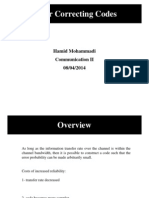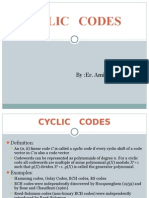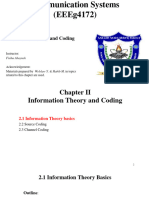Ec2301 Digital Communication Unit-3
Uploaded by
parthidhanEc2301 Digital Communication Unit-3
Uploaded by
parthidhanEC2301 DIGITAL COMMUNICATION Unit-3
1) What are the four objectives of a channel code? I) to have the capability to detect and correct code errors Ii)to be able to keep the over- head of error control and correction as minimum as practicable Iii)to be able to encode the symbol in a fast and efficient way Iv)to be able to decode the symbol in a fast and efficiency way 2) What are the error control methods? I)error detection and retransmission Ii)error detection and correction 3) Write the two basic categories of error-correction code. I) block code and II) Convolution codes 4) What is meant by code word? In block codes, each block of k information bits is encoded into a block of n bits(n>k).this n-bit block is called a code word. If the word is code, it is called a code word 5) What is meant by systematic code? The n-k check bits are divided from the message bits and added to them. When the k information bits appear at the beginning of a code word, the code is called a systematic code. 6) What is meant by parity check codes? And its type. The simplest block code is a parity check code where number of check bit is 1 only and the check bit is derived to generate a particular parity in the entire code word. Parity may be of two types I)even parity 2)odd parity 7) What is word? In code theory , the data stream being investigated is generally called a word. A word is a sequence of symbols. 8) Define hamming weight. The hamming weight of a code word is equal to the number of non-zero components in it. If the codeword is denoted by c,then the hamming weight is denoted by w(c). For example Codeword 0110100 1000001 hamming weight 3 2
0000000
9) Define hamming distance . The hamming distance between two codeword is the number of places the codewords differ. 10) What is block code and block length? A block code is a set of fixed length codeword. The fixed length of these codeword is called the block length and typically denoted by n. Thus a block code of size m = qk for some integer k, and the block code is called (n,k) code. 11) What is code rate? The code rate of an (n,k) code is the ratio (k/n). The code rate denotes the fraction of the codeword that consist of the information digits. It is always unity. 12) Define minimum distance and minimum weight. The minimum distance of a code is the smallest hamming distance between any pair o codeword in the code. The minimum weight of a code is the smallest weight of any non-zero codeword and is denoted by w*. 13) Write the general equation of the relation between the minimum distance and the error control capability of the code. In general , if d* is the minimum distance of a block code, then (a) (d*-1)/2 error can be corrected if d* is odd. (b) (d*-2)/2 error can be corrected and d*/2 error can be detected if d* is even. 14) Write the properties of linear line code. a linear code has the following properties: (a) The sum of two code words belonging to the code is also a codeword belonging to the code. (b) The all-zero word is always a code word. (c) The minimum distance between two codewords of a linear code is equal to the minimum weight of the code. 15) Define generator matrix. In a linear code, each of the 2k code words can be expressed as linear combination of k linearly independent code vector. We can therefore , define a generator matrix g, the row of which form the basis vector of the subspace spanned by a linear block code c. The generator matrix will be a kn matrix with rank k. 16) problem: A generator matrix for a (6,3) block code is given below. Find all code vector of the code. 100101
[g]=
010110 001011
Solution: The information word i for this code is of length 3. So, for all the 23 = 8 possible is we can find the codewords c Information 000 001 010 011 100 101 code vector 000000 001011 010110 011101 100101 101110 .
16) When the generator matrix is called systematic form? In a systematic block codeword, the information bits come first and the check bits come thereafter. The corresponding generator matrix form is called the systematic form of the generator matrix. In systematic form, g can be written as ,
[ g ]kn=[ [ i ]kk[ p ] k(n-k) ]
17) What is coefficient matrix and parity check matrix?
[ g ]kn=[ [ i ]kk[ p ] k(n-k) ]
Where [i] is an identity matrix and [p] is a matrix completely characterising the (n,k) block code. [p] is called thr coefficient matrix. To 18) What is basis function? The generating set of vector is said to span the subspace. The smallest linearly independent set that spans the subspace is called a basis of the subspace. 19) Define parity check matrix. Let us define a matrix h, called the parity check matrix, that will enable us to decode the received vector. For each (kn) generator matrix g, there exists an (n-k)n matrix h, such that the rows of g are orthogonal to the rows of h: that is ght = 0, where ht is the transpose of h, and zeros matrix. To fulfil the orthogonality requirements for a systematic code, the component of the h matrix are written as H=[in-k pt ] 20) Types of decoder. I)complete decoder Ii) incomplete decoder
21) What is complete decoder? It can randomly decide in favour of any one of the equally distant neighbours. These decoders are called complete decoder. 22) What is incomplete decoder? Request the transmitter for retransmission. These decoder are called incomplete decoders. 23) What is decoding sphere? All the received code words at a hamming distance of t or less from a valid codeword will lie within a circle of radius t and centred at the valid codeword. This sphere is called the decoding sphere of the corresponding codeword. 24) What is a perfect code? Let the received word be denoted by r. In general, it isa the sum of the transmitted code word c and an error word, i.e. R=c+e. If we form the product of r and ht, we get a vector called syndrome [s]=[r][ht] or the syndrome is calculated from e by using [s]=[e][ht] 25) Define cyclic code. I) c is a linear code Ii) any cyclic shift of a codeword is also a code word. 26) What is CRC? CRC stands for cyclic redundancy check codes. These codes are good at detecting burst of errors. The block codes are good at detecting and correcting errors such as error occurring at random position of the codeword. CRC code is an example of such a burst-error correcting code. 27) What are the error patterns detect by crc? A) all error bursts of length n-k or less. B) a fraction of error burst of length equal to n-k +1 . The fraction of equals 1-2-(n-k-1) . C) a fraction of error burst of length greater than n-k+1. The fraction equals 1-2-(n-k-1) . D) all combination of dmin -1 errors. E)all error patterns with an odd number of errors if the generator polynomial g(x) for the code has an even number of non -zero coefficients. 28) What is free distance , code gain, code rate? I) minimum hamming distance for a convolution code is called free distance(dfree). Ii) the quantity dfree rc is known as the coding gain.(rc- code rate; dfree free distance) Iii) the ratio of n,k is called code rate.(n/k).
29) Describe convolution code? A convolution code is described by three integer n,k and k. 30) What are the varies representation of convolution encoder? I) connection pictorial Ii)connection vectors Iii) state diagram Iv) tree diagram V)trellis diagram 31) What are the disadvantages of the sequential decoding scheme? I) the number of incorrect path branches and hence the computation complexity is a random variable depending on the channel noise. Ii) to make storage requirements easier, the decoding speed needs to be 10 to 20 times faster than the incoming data rate. This limits the maximum data rate capability. Iii) the average number of branches can occasionally become very large and may result in a storage overflow, causing relatively long sequences to be erased.
You might also like
- A Course in Error-Correcting Codes - Justesen and Høholdt100% (1)A Course in Error-Correcting Codes - Justesen and Høholdt204 pages
- Error Control Coding: The Structured SequencesNo ratings yetError Control Coding: The Structured Sequences65 pages
- Telecommunications Engineering: Ele5Tel 1No ratings yetTelecommunications Engineering: Ele5Tel 131 pages
- Unit Iv Linear Block Codes: Channel EncoderNo ratings yetUnit Iv Linear Block Codes: Channel Encoder26 pages
- Linear Block Codes: Lecture Notes by Y. N. TrivediNo ratings yetLinear Block Codes: Lecture Notes by Y. N. Trivedi12 pages
- Information Theory & Coding (INFO 2111) : Time Allotted: 3 Hrs Full Marks: 70No ratings yetInformation Theory & Coding (INFO 2111) : Time Allotted: 3 Hrs Full Marks: 703 pages
- Supplementary Material For Coding TheoryNo ratings yetSupplementary Material For Coding Theory41 pages
- Channel Coding: TM355: Communication TechnologiesNo ratings yetChannel Coding: TM355: Communication Technologies58 pages
- 5CS3-01: Information Theory & Coding: Unit-3 Linear Block CodeNo ratings yet5CS3-01: Information Theory & Coding: Unit-3 Linear Block Code75 pages
- Information Theory and Coding Sample Question 2021No ratings yetInformation Theory and Coding Sample Question 20215 pages
- 3F4 Error Control Coding: Dr. I. J. WassellNo ratings yet3F4 Error Control Coding: Dr. I. J. Wassell70 pages
- Lecture Notes On Cryptographic Boolean Functions: Anne CanteautNo ratings yetLecture Notes On Cryptographic Boolean Functions: Anne Canteaut48 pages
- New Non-Equivalent (Self-Dual) MDS Codes From Elliptic Curves (Hao Chen)No ratings yetNew Non-Equivalent (Self-Dual) MDS Codes From Elliptic Curves (Hao Chen)24 pages
- Information Theory Coding And Cryptography 3rd Edition Ranjan Bose instant download100% (1)Information Theory Coding And Cryptography 3rd Edition Ranjan Bose instant download50 pages
- Advanced Digital Communications (Ee5511) : MSC Module of Wireless Communication SystemNo ratings yetAdvanced Digital Communications (Ee5511) : MSC Module of Wireless Communication System54 pages
- Menu 634094714561650000 BE IT NEW Course Structure 2009No ratings yetMenu 634094714561650000 BE IT NEW Course Structure 2009104 pages
- IAT-III Question Paper With Solution of 18EC54 Information Theory and Coding Dec-2020-Harsha B KNo ratings yetIAT-III Question Paper With Solution of 18EC54 Information Theory and Coding Dec-2020-Harsha B K24 pages
- Chapter 5: Linear Block Codes: Vahid MeghdadiNo ratings yetChapter 5: Linear Block Codes: Vahid Meghdadi47 pages
- Solved ISRO Scientist or Engineer Electronics 2018 Paper With SolutionsNo ratings yetSolved ISRO Scientist or Engineer Electronics 2018 Paper With Solutions30 pages
- A Course in Error-Correcting Codes - Justesen and HøholdtA Course in Error-Correcting Codes - Justesen and Høholdt
- Linear Block Codes: Lecture Notes by Y. N. TrivediLinear Block Codes: Lecture Notes by Y. N. Trivedi
- Information Theory & Coding (INFO 2111) : Time Allotted: 3 Hrs Full Marks: 70Information Theory & Coding (INFO 2111) : Time Allotted: 3 Hrs Full Marks: 70
- 5CS3-01: Information Theory & Coding: Unit-3 Linear Block Code5CS3-01: Information Theory & Coding: Unit-3 Linear Block Code
- Information Theory and Coding Sample Question 2021Information Theory and Coding Sample Question 2021
- Error-Correction on Non-Standard Communication ChannelsFrom EverandError-Correction on Non-Standard Communication Channels
- Digital Communications 1: Source and Channel CodingFrom EverandDigital Communications 1: Source and Channel Coding
- Lecture Notes On Cryptographic Boolean Functions: Anne CanteautLecture Notes On Cryptographic Boolean Functions: Anne Canteaut
- New Non-Equivalent (Self-Dual) MDS Codes From Elliptic Curves (Hao Chen)New Non-Equivalent (Self-Dual) MDS Codes From Elliptic Curves (Hao Chen)
- Information Theory Coding And Cryptography 3rd Edition Ranjan Bose instant downloadInformation Theory Coding And Cryptography 3rd Edition Ranjan Bose instant download
- Advanced Digital Communications (Ee5511) : MSC Module of Wireless Communication SystemAdvanced Digital Communications (Ee5511) : MSC Module of Wireless Communication System
- Menu 634094714561650000 BE IT NEW Course Structure 2009Menu 634094714561650000 BE IT NEW Course Structure 2009
- IAT-III Question Paper With Solution of 18EC54 Information Theory and Coding Dec-2020-Harsha B KIAT-III Question Paper With Solution of 18EC54 Information Theory and Coding Dec-2020-Harsha B K
- Solved ISRO Scientist or Engineer Electronics 2018 Paper With SolutionsSolved ISRO Scientist or Engineer Electronics 2018 Paper With Solutions























































































